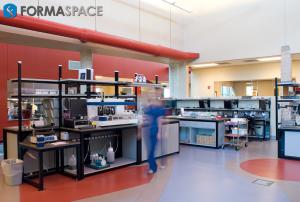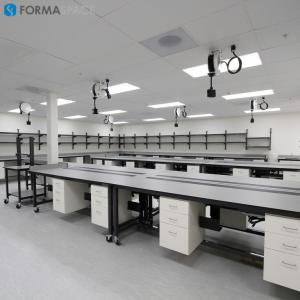How to Avoid Mistakes in the Wet Lab
Making a mistake in the wet lab can have serious consequences on health, safety and your organization's financials. Read this article to prevent those mistakes!
Errors made by diagnostic labs can have life or death consequences for patients in the healthcare system who are relying upon laboratory test results.”
AUSTIN, TEXAS, USA, May 8, 2017 /EINPresswire.com/ -- Constant vigilance is the watchword to help prevent serious errors while working in a wet lab environment. These recommendations can help you work more safely.— Formaspace
As experienced researchers and technicians know, working in a wet laboratory can be a very dangerous place indeed. Some might say that both Murphy’s Law and the Law of Unintended Consequences work overtime in wet lab environments. But it’s really no joking matter. Making a mistake in the wet lab can have very serious consequences for your own personal health and safety – as well as for those around you.
Physical Dangers to Human Health and Safety in Wet Labs
The combination of infectious agents, sharp tool, and needles, fragile glassware, high-speed centrifuges, and liquefied gases under pressure makes wet laboratories a demanding environment where small mistakes can spell disaster.
Here are just a few of the potential types of accidents that can occur in the wet lab:
- Punctures and cuts from so-called sharps, such as needle sticks, broken pipettes, and glass slides can lead to dangerous Laboratory-Acquired Infections (LAIs).
- Ingestion of chemicals or biological pathogens can occur due to incorrect procedures, such as mouth pipetting, allowing food and beverages in the lab, absentmindedly placing a pen or pencil in the mouth, wearing contact lenses, or using your keyboard or smartphone in the laboratory without a protective cover.
- Inhalation of aerosols, including fungus spores, micro particulates, viruses, or bacteria can be caused by improper fume hood use, unsafe centrifuge handling procedures, opening closed test tubes at close range without proper PPE (personal protective equipment), or mistakes in handling vacuum pumps safely.
- Implosion accidents can occur when vacuum flasks or bell jars fail, resulting in sharp debris from broken glass shooting out into laboratory technician’s unprotected eyes, face or hands.
- Explosions in the laboratory can be caused by multiple factors, including mishandling of liquid gases (such as liquid nitrogen, helium or oxygen) in cryogenic containers, or the accidental mixing of incompatible compounds due to handling errors caused by mislabeled or LASA (look-alike, sound-alike) compounds.
Consequences of Lab Errors: What is the True Cost?
There’s not a central database that documents the cost of errors made in wet laboratories, at least not yet.
A Blue-Ribbon Panel set up by the CDC (Centers for Disease Control) is on record asking for a voluntary, non-punitive surveillance and reporting system – where anonymous participants could submit accident reports – with the intent that the greater laboratory science community could learn to prevent repeating mistakes again in the future.
In the meantime, different agencies do report on lab accidents and their associated costs, including the CDC itself, which publishes their Morbidity and Mortality Weekly Report (MMWR).
According to the CDC’s MMWR reports, bacteria is responsible for more than 40% of laboratory-acquired infections; more than 37 different bacteria species have been identified as common etiologic agents.
Among viruses, Hepatitis B is the most frequent laboratory-acquired viral infection; laboratory workers are infected with Hepatitis B at a rate that is 2 to 4 times that of the general population.
How do laboratory workers acquire these infections? According to the CDC, the five most prominent sources of laboratory-acquired infections are:
1) Accidental inoculation by syringe needles or contaminated sharps.
2) Spills and splashes on skin or mucous membranes.
3) Ingestion or exposure by mouth pipetting or touching the mouse or eyes with fingers or contaminated objects.
4) Laboratory research activities involving animal bites or scratches.
5) Inhalation of infectious aerosols.
Reported statistics indicate that items 1 through 4 account for 20% of Laboratory-Acquired Infections (LAIs). What about the other 80%? The answer is we often don’t know for sure – it’s very difficult in practice to identify a specific event causing an infection, but it’s suspected that inhalation of infectious aerosols is a major cause of LAI’s.
What’s the Cost of Errors by Diagnostic Labs to the Healthcare System?
Errors made by diagnostic labs can have life or death consequences for patients in the healthcare system who are relying upon laboratory test results.
Frustratingly, the most common medical “laboratory errors” seem to be outside the laboratory. According to a study by ECRI Institute PSO, only 4% of nearly 2500 laboratory events (e.g. errors) occurred in the lab itself.
The main culprits were in the Pre-analytical phase:
- Mislabeled specimens
- Specimens with no label or an incomplete label
and in the Post-Analytical phase:
- Test results that were delayed or missing
Earlier this year, Alia Atwaru MHA, of Northwell Health Labs (NWL) presented a study to the American Society for Clinical Pathology that quantifies the economic cost of diagnostic laboratory test errors at somewhere between $200 – $2000 per error.
To be clear, these figures estimate the economic cost of having to repeat laboratory tests. While these numbers do represent a significant amount of money wasted on unnecessary, duplicate lab tests, these costs pale in comparison to the potentially serious health consequences to a patient stemming from faulty laboratory tests. Examples of some of the more severe consequences include:
- Unnecessary surgery or treatments performed on the patient, due to an inaccurate lab test.
- Surgery or medically necessary treatments not performed on the patient, due to an inaccurate lab test.
- Misdiagnosis and improper treatment of a patient, due to an inaccurate lab test.
As you are certainly aware, any of the above scenarios could have life or death consequences, and be subject to actionable malpractice cases costing upwards of millions of dollars.
What Systematic Changes Can Reduce Wet Lab Mistakes?
Laboratory experts agree that more needs to be done to improve laboratory safety.
Read more ... https://formaspace.com/articles/wet-lab/avoid-mistakes-wet-lab/?utm_source=einpresswire&utm_medium=content&utm_campaign=050817
Kelsea Marshall
Formaspace
8002511505
email us here



